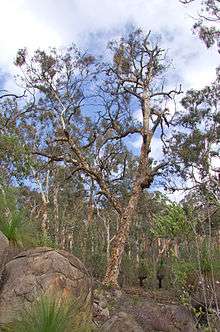Eucalyptus accedens
| Powder-barked wandoo | |
|---|---|
 | |
| Eucalyptus accedens in the Avon Valley National Park | |
| Scientific classification | |
| Kingdom: | Plantae |
| (unranked): | Angiosperms |
| (unranked): | Eudicots |
| (unranked): | Rosids |
| Order: | Myrtales |
| Family: | Myrtaceae |
| Genus: | Eucalyptus |
| Species: | E. accedens |
| Binomial name | |
| Eucalyptus accedens W.Fitzg. | |
.jpg)

Eucalyptus accedens, commonly known as smooth bark wandoo,[1] powder-barked wandoo or powderbark wandoo is a eucalypt native to Western Australia.[2]
Description
Mature trees typically grow to a height of 15 to 25 metres (49 to 82 ft)[3] with branches high up the trunk[2] and forms a lignotuber. The tree diameter can be as large as 1.5 metres (5 ft) and hollows will readily form in dead branches or where limbs have fallen.[4]
The smooth bark is notable for being covered in a talc-like powder. It is pale-white when fresh, turning a shade of orange before being shed again.[2] The adult leaves are alternate, concolorous and a dull blue-green colour. The blade is 8 to 18 centimetres (3.1 to 7.1 in) in length and 1.2 to 3 cm (0.47 to 1.18 in) wide with a lanceolate shape and a base tapers to the petiole and a pointed apex. The leaf petioles are 1.3 to 3.2 cm (0.51 to 1.26 in) long.[5]
White flowers are produced between December and April.[3] The inflorescences is single and axillary with a peduncle 0.7 to 1.7 cm (0.28 to 0.67 in) long. It will form pedicellate buds in clusters od 7, 9 or 11, with cylindrical to obovoid or ovoid shape. It forms fruit later that are pedicellate, and cylindrical to barrel-shaped with a width of 0.5 to 0.9 cm (0.20 to 0.35 in) containing brown seeds with a ovoid or flattened-ovoid shape and a length of 1.5 to 2.5 mm (0.06 to 0.10 in).[5]
Eucalyptus wandoo and E. accedens have a very similar appearnace, but can be distinguished by the orangey coloured powdery coating on the bark of E. accedens that appears seasonally, it also has larger, more rounded buds and more rounded juvenile foliage.[4]
Habitat
E. accedens will grow is gravelly or clay-loam soils over laterite. It is commonly found on stony ridges or lateritic breakaways[3] and often above stands of Eucalyptus wandoo.[4]
It's range extends from south east of Geraldton in the Mid West region south through the Darling Range as far as Williams, Western Australia in the Wheatbelt region.[5]
Occurring on woodland areas associated species include E. wandoo as E. wandoo often occurs below E. accedens in the overstorey landscape, and occasionally with E. astringens, and sometimes with E. marginata on the western fringe. In the understorey shrubs such as Hypocalymma angustifolia, Hibbertia hypericoides, Hakea lissocarpha, Acacia pulchella, Hovea chorizemifolia, Gastrolobium microcarpum, Lepidosperma leptostachyum and Bossiaea eriocarpa are often found.[4]
History
The species was first described by the botanist William Vincent Fitzgerald in 1904 in the journal Journal of the Western Australian Natural History Society from samples Fitzgerald had collected near Pingelly in 1903.[5] The name accedens was chosen as it is the latin work for approaching or resembling, referring to the similarity of the species to E. wandoo.[5]
E. accedens is now commonly sold as an ornamental shade or shelter tree. Bark is often used to deter ants. It tolerates a wide range of soil types except for lime and is reasonably drought tolerant and is available as seed or seedlings.[1][6]
The powder that accumulates on the trunk was tested as a deterrent for arthropods in 2004. The results demonstrated that ant mortality was much greater paper discs coated with the pwder than on control discs.[7]
See also
References
- 1 2 "Eucalyptus accedens 'Smooth Bark Wandoo'". Ellenby Tree Farm. 2015. Retrieved 23 October 2016.
- 1 2 3 Holliday, I. (2002). A field guide to Australian trees (3rd ed.). Frenchs Forest, N.S.W.: New Holland. ISBN 978-1-876334-79-6.
- 1 2 3 "Eucalyptus accedens". FloraBase. Western Australian Government Department of Parks and Wildlife.
- 1 2 3 4 "Eucalyptus accedens". Wheatbelt Woodlands. Department of Environment and Conservation. Retrieved 23 October 2016.
- 1 2 3 4 5 "Powder-bark wandoo Eucalyptus accedens W.Fitzg., J. W. Austral. Nat. Hist. Soc. 1: 21 (1904)". Euclid. CSIRO. 2002. Retrieved 23 October 2016.
- ↑ "Eucalyptus accedens". Apace WA. Retrieved 23 October 2016.
- ↑ J D Majer, R D Cocquyt and H F Recher (2004). "Powdery bark in Eucalyptus accedens deters arthropods? An evaluation using ants" (PDF). Royal Society of Western Australia. Retrieved 23 October 2016.